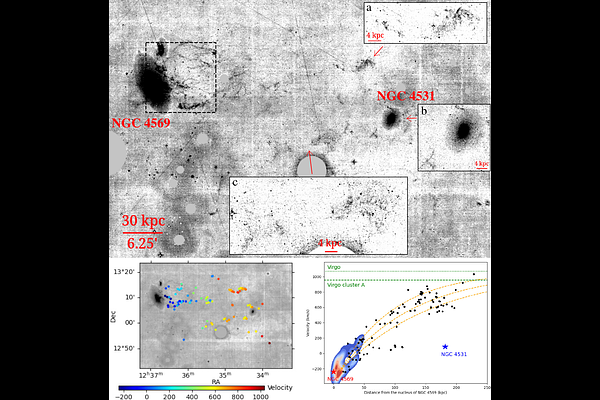A Virgo Environmental Survey Tracing Ionised Gas Emission (VESTIGE). XIX. The discovery of a spectacular 230 kpc Halpha tail following NGC 4569 in the Virgo cluster

A Virgo Environmental Survey Tracing Ionised Gas Emission (VESTIGE). XIX. The discovery of a spectacular 230 kpc Halpha tail following NGC 4569 in the Virgo cluster
M. Sun, H. Le, B. Epinat, A. Boselli, R. Luo, K. Hosogi, N. Pichette, W. Forman, C. Sarazin, M. Fossati, H. Chen, E. Sarpa, J. Braine, J. C. Cuillandre, S. Gwyn, G. Hensler, S. Martocchia, B. Vollmer
AbstractContext. Galaxies fly inside galaxy clusters and ram pressure by the ICM can remove a large amount of the ISM from the galaxy, and deposit the gas in the ICM. The ISM decoupled from the host galaxy leaves a long trail following the moving galaxy. Such long trails track the galaxy motion and can be detected with sensitive data in Halpha. Aims. We study the Halpha tail trailing NGC 4569 in the Virgo cluster. Methods. The initial discovery was made with the deep Halpha imaging data with CFHT, from the VESTIGE project. The follow-up spectroscopic observations were made with APO/DIS, MMT/Binospec and CFHT/SITELLE. Results. Besides the known 80 kpc Halpha tail downstream of NGC 4569, the deep Halpha imaging data allow the Halpha tail detected to at least 230 kpc from the galaxy. More importantly, the Halpha clumps implied from the imaging data are confirmed with the spectroscopic data. The Halpha clumps show a smooth radial velocity gradient across about 1300 km/s, eventually reaching the velocity of the cluster. We build a simple model to explain the deceleration of stripped clumps and constrain the age to about 0.9 Gyr. Conclusions. This discovery, for the first time, demonstrates the full deceleration process of the stripped ISM. This discovery also showcases the potential with wide-field Halpha survey on galaxy clusters to discover intracluster optical emission-line clouds originated from cluster galaxies. These clouds provide kinematic tracers to the infall history of cluster galaxies and the turbulence in the ICM. They are also excellent multi-phase objects to study the relevant important physical processes.